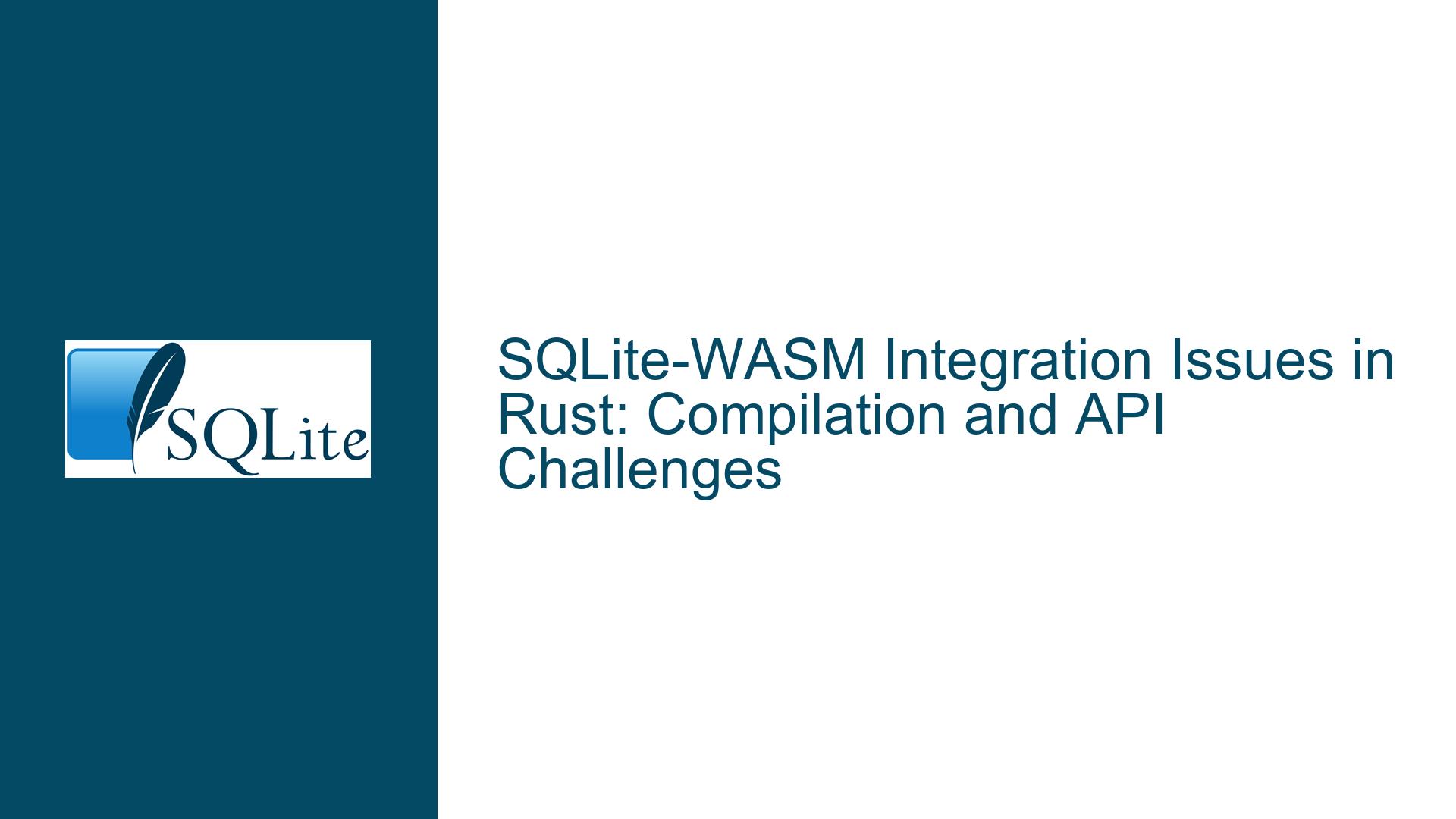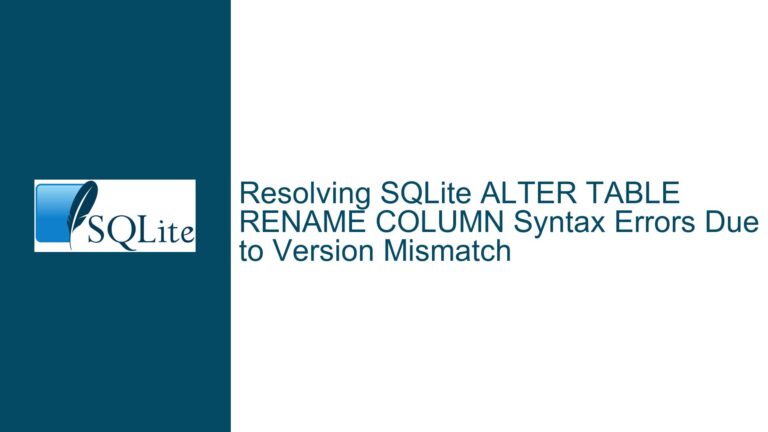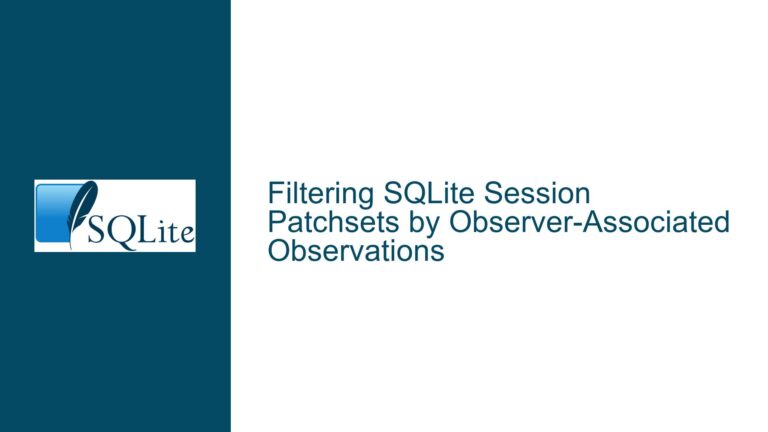SQLite-WASM Integration Issues in Rust: Compilation and API Challenges
Issue Overview: Compiling SQLite for WASM and Implementing a C-like API in Rust
The core issue revolves around integrating SQLite into a Rust environment targeting the wasm32-unknown-unknown architecture. This architecture is commonly used in Rust for WebAssembly (WASM) applications, which are designed to run in web browsers. The challenge lies in compiling SQLite3 for this target and providing a usable C-like API for Rust developers. The problem is multifaceted, involving both the compilation of SQLite3 with specific flags and the implementation of a virtual file system (VFS) to handle file operations in a WASM environment.
The first part of the issue involves compiling SQLite3 with the -DSQLITE_OS_OTHER flag. This flag is used to indicate that SQLite3 is being compiled for an operating system other than the standard ones it supports out of the box. When this flag is set, SQLite3 expects the developer to provide implementations for certain external symbols, such as malloc, realloc, and free. These symbols are typically provided by the operating system, but in a WASM environment, they must be implemented manually. Additionally, the developer has ported the opfs-sahpool VFS from sqlite-wasm and implemented a default memory VFS. The opfs-sahpool VFS is designed to work with the Origin Private File System (OPFS), which is a file system API available in modern web browsers. The memory VFS, on the other hand, is a simpler file system that stores all data in memory, which is useful for temporary databases or when persistent storage is not required.
The second part of the issue involves wrapping the official sqlite-wasm library to provide a usable C-like API. The sqlite-wasm library is a version of SQLite3 that has been compiled to WebAssembly, making it suitable for use in web browsers. However, the API provided by sqlite-wasm is not directly usable in Rust, as it is designed for use in JavaScript. To make it usable in Rust, the developer needs to create a wrapper that exposes a C-like API, which can then be called from Rust code. This involves translating the JavaScript API into a form that can be used in Rust, which can be a complex task due to the differences between the two languages.
Possible Causes: Challenges in Compiling SQLite for WASM and API Wrapping
The challenges in compiling SQLite for WASM and wrapping the API can be attributed to several factors. First, the wasm32-unknown-unknown target is a relatively new and specialized environment, and SQLite3 was not originally designed with this target in mind. As a result, certain assumptions that SQLite3 makes about the underlying operating system may not hold true in a WASM environment. For example, SQLite3 expects certain system calls to be available, such as those for memory allocation and file operations. In a WASM environment, these system calls must be implemented manually, which can be a complex and error-prone process.
Another challenge is the need to implement a virtual file system (VFS) that works in a WASM environment. The VFS is responsible for handling file operations, such as reading and writing data to disk. In a traditional operating system, the VFS is provided by the OS, but in a WASM environment, the developer must provide their own implementation. The opfs-sahpool VFS is one such implementation, but it is designed to work with the Origin Private File System (OPFS), which is not available in all web browsers. Additionally, the memory VFS is a simpler alternative, but it has limitations, such as the inability to persist data across sessions.
The process of wrapping the official sqlite-wasm library to provide a C-like API is also fraught with challenges. The sqlite-wasm library is designed to be used in JavaScript, and its API reflects this. For example, the API may use JavaScript-specific data types, such as objects and arrays, which do not have direct equivalents in Rust. Additionally, the API may rely on JavaScript-specific features, such as callbacks and promises, which must be translated into a form that can be used in Rust. This translation process can be complex and may require a deep understanding of both JavaScript and Rust.
Troubleshooting Steps, Solutions & Fixes: Addressing Compilation and API Challenges
To address the challenges of compiling SQLite for WASM and wrapping the API, several steps can be taken. First, when compiling SQLite3 with the -DSQLITE_OS_OTHER flag, it is important to ensure that all required external symbols are implemented correctly. This includes malloc, realloc, and free, which are used for memory allocation and deallocation. These functions can be implemented using the WebAssembly Memory API, which provides a way to allocate and manage memory in a WASM environment. Additionally, the developer should ensure that the opfs-sahpool VFS is correctly implemented and that it works with the Origin Private File System (OPFS). If OPFS is not available, the developer may need to fall back to the memory VFS, but they should be aware of its limitations.
When implementing the VFS, it is important to consider the specific requirements of the application. For example, if the application requires persistent storage, the opfs-sahpool VFS should be used, but the developer should also provide a fallback option in case OPFS is not available. Additionally, the developer should ensure that the VFS is thread-safe, as SQLite3 may be accessed from multiple threads in a web browser environment. This can be achieved by using synchronization primitives, such as mutexes, to protect shared resources.
To wrap the official sqlite-wasm library and provide a C-like API, the developer should start by analyzing the JavaScript API and identifying the functions and data types that need to be translated. This may involve creating Rust structs and enums to represent JavaScript objects and arrays, and implementing Rust functions that call the corresponding JavaScript functions. The developer should also consider using a library, such as wasm-bindgen, to facilitate the interaction between Rust and JavaScript. wasm-bindgen provides a way to generate Rust bindings for JavaScript functions, making it easier to call JavaScript code from Rust.
Once the C-like API has been implemented, the developer should thoroughly test it to ensure that it works correctly in a WASM environment. This includes testing all functions and data types, as well as testing the API in different web browsers to ensure compatibility. The developer should also consider providing documentation and examples to help other developers use the API.
In conclusion, integrating SQLite into a Rust environment targeting the wasm32-unknown-unknown architecture is a complex task that involves both compiling SQLite3 with specific flags and implementing a virtual file system (VFS) for a WASM environment. Additionally, the developer must wrap the official sqlite-wasm library to provide a usable C-like API for Rust developers. By carefully implementing the required external symbols, choosing the appropriate VFS, and using tools like wasm-bindgen to facilitate the interaction between Rust and JavaScript, the developer can successfully integrate SQLite into a Rust WASM application.






